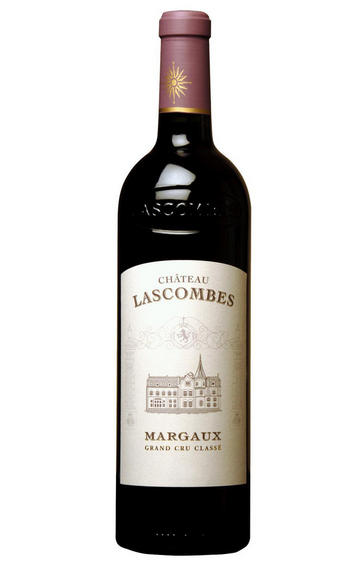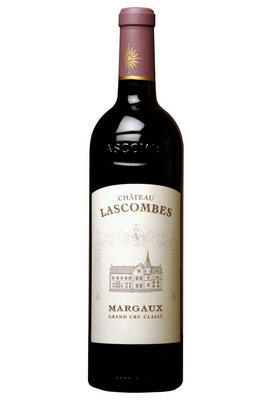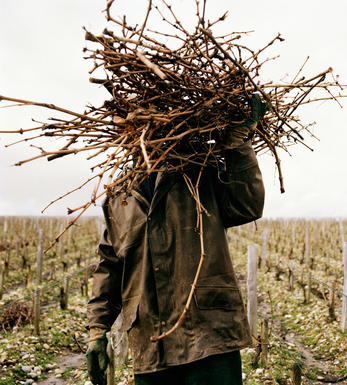
2010 Château Lascombes, Margaux, Bordeaux

Critics reviews
Robert M. Parker, Jr. - 28/02/2013
(Jancis Robinson MW- jancis robinson.com 18 Apr 2011)
(James Molesworth – The Wine Spectator – Apr 2011)
(96 Robert Parker- Wine Advocate- Feb 2013)
While this large property is composed of a huge number of small parcels that must require military-like precision to harvest, the quality of the wines over the last decade has been remarkable. The 2010 may turn out to be the greatest Lascombes ever made. It boasts a dense purple color along with an extraordinarily uplifted set of aromatics consisting of blueberry liqueur, black cherries, subtle smoke, crushed rocks and restrained oak. Massive fruit, an unctuous texture, a skyscraper-like mid-palate and stunning definition (because of good acids and a modest pH) have resulted in a formidable wine that will benefit from 5-6 years of cellaring, and should keep for 30 years. A brilliant effort!
(94-97 Robert Parker- Wine Advocate- May 2011)
About this WINE

Chateau Lascombes
Château Lascombes, a 2emé Cru Classé property is one of the largest estates in the Médoc and probably the most fragmented, with around 40 or so different parcels of vines spread throughout the Margaux appellation. It was owned between 1951 and 1971 by Alexis Lichine and was owned by Bass until the 2001. Bass Charrington sold Chateau Lascombes to the American company Colony Capital in 2001.
Colony Capital have invested heavily in the property and in particular have installed a state-of-the-art, stainless steel cuvier. The blend at Lascombes is made up of 55% Cabernet Sauvignon, 40% Merlot and 5% Petit Verdot, and the wine is aged in oak barriques (60% new) for 18 months. Lascombes produces elegant, well-balanced clarets, rich in succulent creamy blackcurrant fruits, which gain further complexity and depth with ageing.

Margaux
If Pauillac can be seen as the bastion of ‘traditional’ Red Bordeaux, then Margaux represents its other facet in producing wines that are among Bordeaux’s most sensual and alluring. It is the largest commune in the Médoc, encompassing the communes of Cantenac, Soussans, Arsac and Labaude, in addition to Margaux itself. Located in the centre of the Haut-Médoc, Margaux is the closest of the important communes to the city of Bordeaux.
The soils in Margaux are the lightest and most gravelly of the Médoc, with some also containing a high percentage of sand. Vineyards located in Cantenac and Margaux make up the core of the appelation with the best vineyard sites being located on well-drained slopes, whose lighter soils give Margaux its deft touch and silky perfumes. Further away from the water, there is a greater clay content and the wines are less dramatically perfumed.
Margaux is the most diffuse of all the Médoc appelations with a reputation for scaling the heights with irreproachable wines such as Ch. Margaux and Ch. Palmer, but also plumbing the depths, with too many other châteaux not fulfilling their potential. There has been an upward shift in recent years, but the appellation cannot yet boast the reliability of St Julien. However, the finest Margaux are exquisitely perfumed and models of refinement and subtlety which have few parallels in Bordeaux.
Recommended Châteaux: Ch. Margaux, Ch. Palmer, Ch. Brane-Cantenac, Ch. Rauzan-Ségla , Ch. Dufort-Vivens, Ch. Ferrière, Ch. du Tertre, Ch. Giscours, Ch. d'Angludet.

Cabernet Sauvignon Blend
Cabernet Sauvignon lends itself particularly well in blends with Merlot. This is actually the archetypal Bordeaux blend, though in different proportions in the sub-regions and sometimes topped up with Cabernet Franc, Malbec, and Petit Verdot.
In the Médoc and Graves the percentage of Cabernet Sauvignon in the blend can range from 95% (Mouton-Rothschild) to as low as 40%. It is particularly suited to the dry, warm, free- draining, gravel-rich soils and is responsible for the redolent cassis characteristics as well as the depth of colour, tannic structure and pronounced acidity of Médoc wines. However 100% Cabernet Sauvignon wines can be slightly hollow-tasting in the middle palate and Merlot with its generous, fleshy fruit flavours acts as a perfect foil by filling in this cavity.
In St-Emilion and Pomerol, the blends are Merlot dominated as Cabernet Sauvignon can struggle to ripen there - when it is included, it adds structure and body to the wine. Sassicaia is the most famous Bordeaux blend in Italy and has spawned many imitations, whereby the blend is now firmly established in the New World and particularly in California and Australia.


Buying options
Add to wishlist
Description
The wine hits all cylinders in 2010. The average alcohol for the bottled wine is 14%. It has a gorgeously sweet nose of creme de cassis, spring flowers, subtle barbecue smoke and charcoal followed by full body, beautiful intensity, great purity, stature and length. The influence of any oak is minimal, despite the fact that 90% new French oak was used. Needless to say, this is an example of modern-styled winemaking at its finest, and arguments that such wines will not age well, do not represent their terroir , and are soul-less, are totally groundless. Give it five or so years of cellaring and drink it over the following 25-30 years. This is one of the great Margaux wines of the vintage.
Robert M. Parker, Jr. - 28/02/2013
wine at a glance
Delivery and quality guarantee